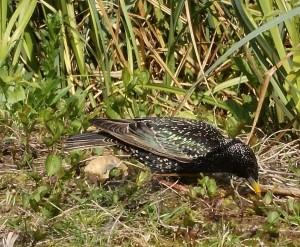
One of the abiding mysteries of London’s natural history is why Starlings act as if they believe they are wading birds. At the Wetland Centre, the flock of Lapwings is constantly accompanied by Starlings, whether in the air or on small muddy islands.
Today, a few starlings were rootling about in front of a reedbed, their handsomely starry plumage giving back the warm sunshiine with green iridescence that for once the camera has managed to catch. They really are beautiful birds in fresh plumage; quite unlike their ‘worn’ plumage, where they just look dark grey-brown and scruffy.
Six warblers today – an early Sedge Warbler squeaking and rasping out its complex rhythms with funky discordant notes a few feet away from the path; some invisible Cetti’s as usual; Blackcaps and surprisingly Whitethroats all about, singing away; a Chiffchaff or two; and a Garden Warbler too.
Out in the pools and on the grazing marsh, a good number of Redshank with their graceful calls, and plenty of activity from Lapwings and Common Terns – these being harassed by Black-Headed Gulls; and overhead an early Hobby, circling like a small dark Peregrine with long wings, high in the sky.
Not many butterflies about – Orange Tip, a very worn Peacock, Brimstone, Small White; and several Bee Flies, like a miniature hummingbird moth with a furry body and a long straight proboscis; but while they keep up the wing action in front of a flower, actually 4 out of 6 legs perch on it! One of the bee flies was hovering over some low vegetation with no flowers, darting down rapidly and repeatedly, at once coming back up, like a damselfly laying eggs: that might be what it was doing.
